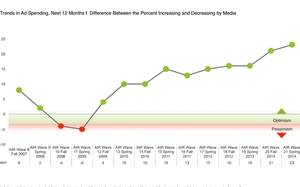Optimism Index Climbs To Highest Level Yet: All Media Except Print And Portals On The Rise
- by Joe Mandese @mp_joemandese, October 30, 2014
In another encouraging sign for the advertising economy, the optimism of ad executives -- both marketers and agency counterparts -- is at its highest level since an industry researcher began tracking it seven years ago. The data, which comes from the Perception Group’s Advertiser Optimism Index, is based on the self-reported perceptions that ad execs have for increasing or decreasing their ad budgets in the next 12 months.
It comes as some ad industry forecasters, particularly Interpublic’s Mediabrands’ Magna unit, predict 2015 will see one of the best rates of ad budget expansion in years, due largely to economists’ predictions that consumer spending -- an important bellwether of advertising growth -- will once again surge next year.
The data should come as relief for big agencies and big media, which have experienced an erratic year of advertising demand so far this year. But not all major media should be optimistic -- particularly print media, which the majority of ad executives continue to be pessimistic about.
advertisement
advertisement
“On an overall basis, the index is at its highest level since we began tracking it seven years ago,” says Perceptions Group co-founder Ken Pearl, adding, "except for magazines and newspapers.”
The overall index, which measures the index point spread between the percentage of ad execs saying they plan to increase spending vs. the percentage planning to decrease spending over the next 12 months, stands at 25, up from 21 six months ago.
However, the index for magazines and newspapers is a negative 4 and 17, respectively.
The greatest optimism continues to be for digital media, especially mobile. The mobile media index stands at a positive 43, while “digital” (a catch-all for online, social and mobile media) is a 41.
With a positive index of 21, cable TV is the next most optimistic ad medium, followed by broadcast TV (6) and radio (3).
Among the non-mobile digital media, social has the strongest optimism (an index of 39), followed by search (36), video (27), programmatic (25), video ad networks (18), non-video ad networks (5) and website publishers (1). The only digital medium to have a net negative index is “portals,” which stand at a minus 6 index.




Expect to see print log further declines. The age of digital has arrived and there is no turning back.
In my marketing classes at Arizona State University I have been learning about the many types of media and how each one plays a significant role in advertising. Some might argue that print media is still very vital because it reaches certain demographics that do not utilize digital media. There are people that prefer to read the newspaper rather than checking it online. These people are the ones keeping print media afloat. I do believe that digital media is much more prominent in this day and age, and it makes sense to focus a majority of spending on this type of media. I wonder if there will ever be a day that newspaper ceases to exist? It sure seems to be getting close to that point. Since I am a millennial I do find that digital media is much more relevant in advertising. I am constantly on my mobile devices utilizing apps and social media. I am exposed to hundreds of ads daily. We have debated in my marketing classes whether or not the ads on mobile devices work. In my opinion, it works if it is done correctly. When I receive an email with some kind of sale, deal, or coupon, I am much more likely to make a purchase. Whereas, when I see a banner ad, I scroll right past it. The world of media and advertising truly fascinates me, and it makes me hopeful to enter the industry knowing that there is such a demand for well-done advertising.